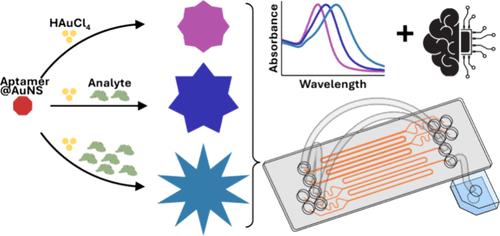Our official English website, www.x-mol.net, welcomes your
feedback! (Note: you will need to create a separate account there.)
Microfluidic Optical Aptasensor for Small Molecules Based on Analyte-Tuned Growth of Gold Nanoseeds and Machine Learning-Enhanced Spectrum Analysis: Rapid Detection of Mycotoxins
ACS Sensors ( IF 8.2 ) Pub Date : 2024-11-07 , DOI: 10.1021/acssensors.4c02739 Marti Z. Hua, Jinxin Liu, M. S. Roopesh, Xiaonan Lu
ACS Sensors ( IF 8.2 ) Pub Date : 2024-11-07 , DOI: 10.1021/acssensors.4c02739 Marti Z. Hua, Jinxin Liu, M. S. Roopesh, Xiaonan Lu

|
Natural toxins, mainly small molecules, are a category of chemical hazards in agri-food systems that pose threats to both public health and food security. Current standard methods for monitoring these toxins, predominantly based on liquid chromatography–mass spectrometry, are costly, labor-intensive, and complex. This study presents the development of a novel microfluidic optical aptasensor for rapid detection of small molecules based on analyte-tuned growth of gold nanoseeds combined with machine learning-enhanced spectrum analysis. We discovered and optimized a previously unreported growth pattern of aptamer-coated nanoparticles in the presence of different concentrations of analyte, enabling the detection of a major mycotoxin in food. The entire analysis was miniaturized on a customized microfluidic platform, allowing for automated spectral acquisition with precise liquid manipulation. A machine learning model, based on random forest with feature engineering, was developed and evaluated for spectrum analysis, significantly enhancing the prediction of mycotoxin concentrations. This approach extended the detection limit determined by the conventional method (∼72 ppb with high variation) to a wider range of 10 ppb to 100 ppm with high accuracy (overall mean absolute percentage error of 5.7%). The developed analytical tool provides a promising solution for detecting small molecules and monitoring chemical hazards in agri-food systems and the environment.
中文翻译:

基于分析物调节的金纳米种子生长和机器学习增强光谱分析的小分子微流体光学 Aptasensor:霉菌毒素的快速检测
天然毒素,主要是小分子,是农业食品体系中的一类化学危害,对公共卫生和粮食安全构成威胁。目前监测这些毒素的标准方法主要基于液相色谱-质谱法,成本高昂、劳动强度大且复杂。本研究提出了一种新型微流体光学适配传感器的开发,用于基于金纳米种子的分析物调节生长结合机器学习增强光谱分析来快速检测小分子。我们发现并优化了在不同浓度分析物存在下先前未报道的适配体包被纳米颗粒的生长模式,从而能够检测食品中的主要霉菌毒素。整个分析在定制的微流体平台上进行小型化,允许通过精确的液体操作进行自动光谱采集。开发了一个基于随机森林和特征工程的机器学习模型,并对其进行了光谱分析评估,显著提高了霉菌毒素浓度的预测。这种方法将传统方法确定的检测限(∼72 ppb,变化较大)扩展到 10 ppb 至 100 ppm 的更宽范围,精度高(总体平均绝对百分比误差为 5.7%)。开发的分析工具为检测农业食品体系和环境中的小分子和监测化学危害提供了一种有前途的解决方案。
更新日期:2024-11-08
中文翻译:

基于分析物调节的金纳米种子生长和机器学习增强光谱分析的小分子微流体光学 Aptasensor:霉菌毒素的快速检测
天然毒素,主要是小分子,是农业食品体系中的一类化学危害,对公共卫生和粮食安全构成威胁。目前监测这些毒素的标准方法主要基于液相色谱-质谱法,成本高昂、劳动强度大且复杂。本研究提出了一种新型微流体光学适配传感器的开发,用于基于金纳米种子的分析物调节生长结合机器学习增强光谱分析来快速检测小分子。我们发现并优化了在不同浓度分析物存在下先前未报道的适配体包被纳米颗粒的生长模式,从而能够检测食品中的主要霉菌毒素。整个分析在定制的微流体平台上进行小型化,允许通过精确的液体操作进行自动光谱采集。开发了一个基于随机森林和特征工程的机器学习模型,并对其进行了光谱分析评估,显著提高了霉菌毒素浓度的预测。这种方法将传统方法确定的检测限(∼72 ppb,变化较大)扩展到 10 ppb 至 100 ppm 的更宽范围,精度高(总体平均绝对百分比误差为 5.7%)。开发的分析工具为检测农业食品体系和环境中的小分子和监测化学危害提供了一种有前途的解决方案。


















































 京公网安备 11010802027423号
京公网安备 11010802027423号